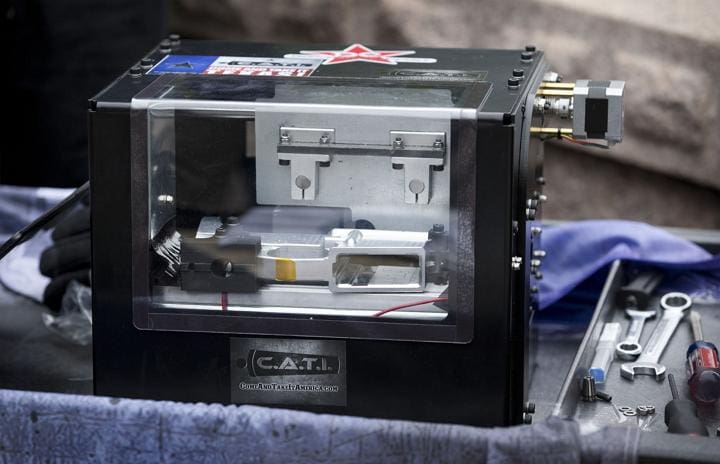The first three stages of the competition went exceptionally well. The key in a match this size is to focus on a single competitor, one on your same skill level, and try to beat them – rather than gunning for Daniel Horner. In my case, I was using Jayson Smith as my yardstick and so far things were looking pretty peachy. The next three stages, though, would have me holding on by the skin of my teeth . . .
Stage 6 was a nifty setup that incorporated the natural terrain of Peacemaker National training Center into its design, using a hilltop and some trees as props for the stage. It was on this very site two years earlier that I had started the first FNH USA 3-Gun Championship, and I still had fond memories of the Barret MRD that was used as a stage gun.
The start position on this stage was with your heels on a pair of X-es, shotgun at port arms. On the start signal, you engage some steel plates with the shotgun, then drop into a prone position for some long range rifle shooting and finally head up a roof simulator to take out some close range steel plates. There were two interesting challenges on this stage, one involving the rifle and one involving the rules.
The thing that scared the most competitors about this stage was the long range targets. You needed to engage a series of targets ranging from 200 yards to 340 yards away, and for some people that was downright impossible.
Long range shooting is my strength, so I was very happy to see some long range steel coming into the match. But for those who don’t do so well at distance, the question becomes one of how many rounds they should pump into a target before they move on. The pros typically say that if you can’t hit it in three rounds to move on, but newer shooters tend to “fixate” on a specific target, ignoring the clock and just trying to hit that one piece of steel until the timer runs out. Keeping from fixating on a target is essential in these situations.
The issue with the rules is that a discarded gun cannot be picked back up, and a handgun cannot be re-holstered. So if you run out of shotgun ammo on the first steel plates and switch to your handgun, you can’t put it back into the holster to continue the stage – you need to run all the way to the end, shoot those targets, ditch it, and then go back to the rifle. It’s a technicality that may have caused one person to become disqualified, but considering the safety implications of a loaded and holstered handgun in the prone position it’s a prudent call.
My biggest issue with this stage was making a rookie mistake. I volunteered to go first on the stage, and as a result I didn’t check that all of my handgun magazines were loaded. At the end of the stage, I ran dry on my handgun and when I went to reload I pulled an empty magazine out of my belt. I had another loaded magazine ready to go, but that mistake is one that no experienced shooter should make. When you step to the line, every magazine should be loaded to capacity. No exceptions.
Stage 5 was quite possibly my favorite stage of the entire match, and while there weren’t any strategy issues there is definitely an illustrative point to be made about re-shoots and the effects of daylight on long distance shooting.
The stage is setup along a hillside, and the targets are arranged in the valley below – some close range steel plates and then a bunch of long range ones. It’s a beautiful sight, but the way in which the targets are placed makes it hard to get a comfortable position from the shooting area (which is a pillbox that Larry made, in which your rifle is staged and must remain).
The original paper we had said that the start position was anywhere in the box with your heel touching the rear fault line, so I did what any good gamer would do and started in the middle of the stage instead of the far end. The position gave me an excellent view of the close range targets, and then a shorter sprint to the pillbox to pick up my rifle. We later found out that the start position is actually along the right most fault line, and led to re-shoot #3 for the match.
The first time I shot the stage, it was at the end of the day. We were exhausted, and the light had moved near the horizon throwing the long range targets into the shadows.
Normally, my process for shooting long range targets is to take a guess at the right elevation and windage, then watch for the puff of dust from the round impacting the dirt, and adjust my hold based on that information. If I fire again before the conditions change, I should hit the target on that second shot every single time. It’s faster and easier than remembering the holds exactly for every distance and reading the wind properly, but it requires the ability to see the targets to work. In this case, the targets were in such a heavy shadow that it was impossible.
The first run through, I ran it in about 160 seconds plus three 20 second penalties for failing to hit a long range plate. In short, it sucked. So when I saw the opportunity for a re-shoot, I was first in line.
The second time I shot the stage I was fully rested and the light was perfectly illuminating the targets. It made the whole stage much easier, and I was able to completely smoke the stage with a time of 85 seconds. It was perfect, and not very far behind the top shooters at the match.
Jayson Smith decided to re-shoot the stage as well, but the re-shoot gods were not with him. His first score was 115 seconds, and he would have beaten it with the raw time on his second run (87 seconds, 2 slower than me). But a couple fatal errors like an improperly grounded shotgun meant that he was pushed back to 117 seconds. Not a train wreck by any stretch of the imagination, but in this instance he would have been better served to have declined the optional re-shoot (he started on the right side of the stage).
It bears repeating: avoid re-shoots at all costs. Unless you screwed up the first time.
Stage 4 was where my match started to go completely off the rails, and it would never recover. You start in the center of a “T” shaped stage, with your rifle staged on one side and your handgun on the other. On the start signal, you engage a bunch of steel plates on either side of a barrier and then a bunch of piggies (with three clay pigeons apiece) at the end of the long part of the “T.”
My original plan to shoot this stage, and the one I should have stuck with, was to use the handgun on all of the steel and then shoot the rifle at the clay pigeons. I’m more accurate with a rifle than a handgun even at 50 yards, and since I started the stage with the handgun holstered on my body it was one less gun to pick up. Also it cut down on running, which was something that my, erm, “large frame” is not built to do.
The way I shot the stage was much different. I was lured by the possibility of hitting multiple steel targets with a single shotgun blast, and instead opted to shoot all the steel targets with the shotgun and then run all the way to the end to shoot the clay pigeons with the handgun. I had just watched two other shooters shoot the stage that way, and it seemed faster. Then again, they were much better handgun shooters than I was, and with a little more luck.
Where this stage went all pear shaped was with a single steel plate on the right hand side. Instead of knocking the plate over, I put just enough lead on it to spin it on the stand to where I was looking at the side of the plate instead of the flat and large face. At that point, it was impossible to knock it over from where I was standing and it forced me to move around and try to hit it.
In most 3-gun competitions, simply turning a plate is good enough to “hit” it. For example, if you spun a plate like this in the 3-gun nation series, you could just keep rolling and it would be good. But according to Larry’s rules, a plate needs to fall to count. And I was screwed.
It took me about 10 to 15 seconds just to find the right position to knock over that one steel plate, and threw off my mojo for the rest of the stage. When I got to the end, my already poor handgun skills combined with my lack of confidence following the issue with the plate and I found myself consistently missing the clay pigeons. It landed me with a final time so shameful that I don’t even want to print it.
From that point, the match started slipping away from me. But thankfully, a 9th inning rally would put me back in the running.







Sounds like your continuing to learn from your mistakes. Thanks for posting and sharing with us.
Love your coverage! Thanks! Great job!
Comments are closed.